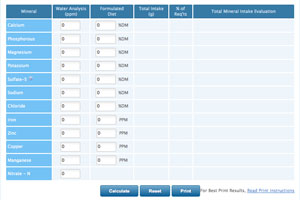Dairy producers, nutritionists and veterinarians now have free access to an online tool that calculates the combined intake of water and feed minerals as compared to NRC requirements. Vi-Cor Dairy Division Vice President Charlie Elrod, Ph.D., has created this web-based water quality evaluation tool that takes dairy rations one step further by accounting for minerals present in the water that cows are consuming.
With this information, producers can determine if an excess of certain minerals may be throwing cows metabolically out of balance, or if there is an opportunity to capture a cost savings by cutting back on supplemented minerals in the ration.
Q. What is the web address?
ELROD: www.waterforcows.com
Q. Why was Water for Cows developed?
ELROD: The concept for Water for Cows grew out of recognition that minerals from water were having a greater impact on cows than anyone was giving them credit. I wanted to develop a tool to help people account for minerals in water and the problems that may arise.
Click here to read an article from Elrod about this topic.
After finishing graduate school, I worked in extension and helped dairy producers in New York figure out problems that they were having with water. Typically, these problems were not very specific, but included things like poor fresh cow transitioning, poor feed efficiency, unthrifty appearance or poor immune systems.
I dug into the water chemistry, and I came to realize that it may not be specific minerals themselves causing problems, but rather the meta-effects of minerals. Basically, the dietary cation-anion difference (DCAD) in water affects rumen fermentation and calcium metabolism in pre-fresh cows.
Q. Who should use Water for Cows?
ELROD: I could see anyone using it – from a dairy producer who has questions on how their water supply is impacting their cows, to a veterinarian trying to get to the bottom of issues on a dairy or to a nutritionist who might be able to reformulate the diet.
 Q. Is there a cost to use the web tool?
Q. Is there a cost to use the web tool?
ELROD: Until recently, there was an annual subscription fee, but the site is now sponsored by Vi-Cor and can be accessed for free. At World Dairy Expo, we heard from a lot of people whose veterinarians and nutritionists had used it, and we wanted to make it more widely available.
Click here or on the image at right to view it at full size in a new window.
Q. How does it work?
ELROD: First, it gives you a prediction of how much water cows will drink by putting in four measures: milk production, dry matter intake, sodium intake and temperature. By entering the water and dietary mineral analysis, it then calculates how many grams of minerals the cow is taking in and how that relates to NRC water predicted intakes and mineral requirements. It tells us whether mineral levels are safe or if we have the potential for problems.
One of the more commonly seen mineral problems is sulfur. At a certain level, sulfur intake antagonizes the availability of trace minerals like copper and selenium. The analysis results give you the knowledge that there is an issue to work around.
Q. What are some of the unique features of the Water for Cows site?
ELROD: The tool allows you to print the results graphically in an easy-to-understand, one-page report. If everything is in the safe range, all of the columns are green. If there is a problem with mineral antagonism, that block prints out in orange as a cautionary flag. If there is a very serious problem, that block prints in red. The report also describes what may be the problem.
Further, this is the only tool I know that combines the DCAD of water with dietary DCAD to come up with an integrated DCAD that tells you the total impact.
Q. Why is this important to understand or utilize?
ELROD: Water could be the missing piece of cow health or productivity. It is not the answer to all problems on all farms, but it could be that missing piece. This website provides a science-based answer to help quantify whether or not water is a concern on your dairy.
The tool gives you a read on total intake DCAD status by calculating the equivalent DCAD from both water and diet. For example, even if the nutritionist has balanced the lactating cow diet, high levels of sodium or chloride in the water can drag the DCAD down and affect rumen fermentation. For pre-fresh cows, if the DCAD is too high, it can lead to metabolic problems.
With this information, there is also the potential for cost savings in the ration. There was a dairy where the nutritionist was able to take 65 percent of the salt out of the diet because the cows were getting sodium and chloride out of the water. PD







